The City of Grande Prairie is a reflection of what is happening across northern Alberta, as cities face down the oil price slump and prepare for better times ahead.
But this northwest Alberta city of 55,032 has more going for it than most, though its economy is closely tied to the oil and gas sector. Widely diversified with a large college, manufacturing, forestry and transport industries, and agriculture, the city is leaning on public works and incentives to keep the engine running.
Right now there are more than $2 billion in construction projects forging ahead, virtually all institutional. This includes nearly $100 million for five new schools, a $730 million regional hospital, a $30 million seniors’ complex and nearly $20 million in sewer and highway upgrades.
But, notes Brian Glavin, manager of Grande Prairie’s economic development office, three new hotels are also under construction and Canfor is spending $15 million upgrading its sawmill.
The city has also launched a downtown enhancement program, worth $20 million, and is dangling some tantalizing incentives to get local business and developers on board. The money includes help to spruce up store facades and to build new rental units.
To encourage more residential rental construction, the city is offering cash of up to $10,000 per door for new rental units and up to $15,000 per door for mixed-use projects downtown, Glavin said.
This year, the city’s $500,000 incentive was oversubscribed, with most of the money earmarked for facade retention. One developer, however, received rental incentives for a 24-unit apartment building.
“This is no-strings attached, $10,000 cash payment per rental unit,” Glavin said.
The city will offer another $500,000 in the next round of annual incentives under the downtown program, he added.
While the money looks good, landlords would likely be counting on a recovery in the price of oil to fill a rental building.
According to August data from the Grande Prairie & Area Association of Realtors, the rental vacancy rate tracks closely to the price of oil.
In the fall of 2014, when the global-standard price for a barrel of West Texas Intermediate (WTI) was US$100, the Grande Prairie rental vacancy rate was around 1.5 per cent. As of this August, with WTI at US$40, the vacancy rate was 10 per cent and climbing.
Grande Prairie’s housing market followed a similar pattern. Housing sales as of mid-2016, at around 1,100 units, were down 40 per cent from the 2014 peak.
But there are signs that not only Grande Prairie landlords but all of northern Alberta may be on the cusp of a recovery in resource prices.
Oil price rising
On October 10, oil closed at US$51.35 a barrel – its highest level since July 2015 – after Russian President Vladimir Putinsaid Russia supports the Organization of Petroleum Exporting Countries’ (OPEC) efforts to cut oil production.
Russia is not a member of the 14-member OPEC, which includes Iran, Nigeria, Saudi Arabia and near-bankrupt Venezuela.
In September, OPEC members agreed to a preliminary accord to limit oil production as a way to deal with a global supply glut. No details of the deal will be announced until the next official OPEC meeting November 30 in Vienna.
“I’m going to say that the market is cozying up to the fact that there will some quota limiting production by the OPEC members and Russia,” said Ian Nakamoto, director of research at Montreal-based MacDougall, MacDougall & MacTier Inc.
Nakamoto anticipates oil prices will continue to climb and be closer to the US$60 a barrel mark by this time next year.
Grande Prairie is home to a number of major oil and gas industry regional offices, such as ConocoPhillips,Canadian Natural Resources, Halliburtonand Trican. The city’s service centre extends into northeast B.C.’s natural gas industry.
There is also good news on that front: the federal government has approved the first large liquefied natural gas export project in B.C., which will tap into gas fields close to Alberta’s northern border.



